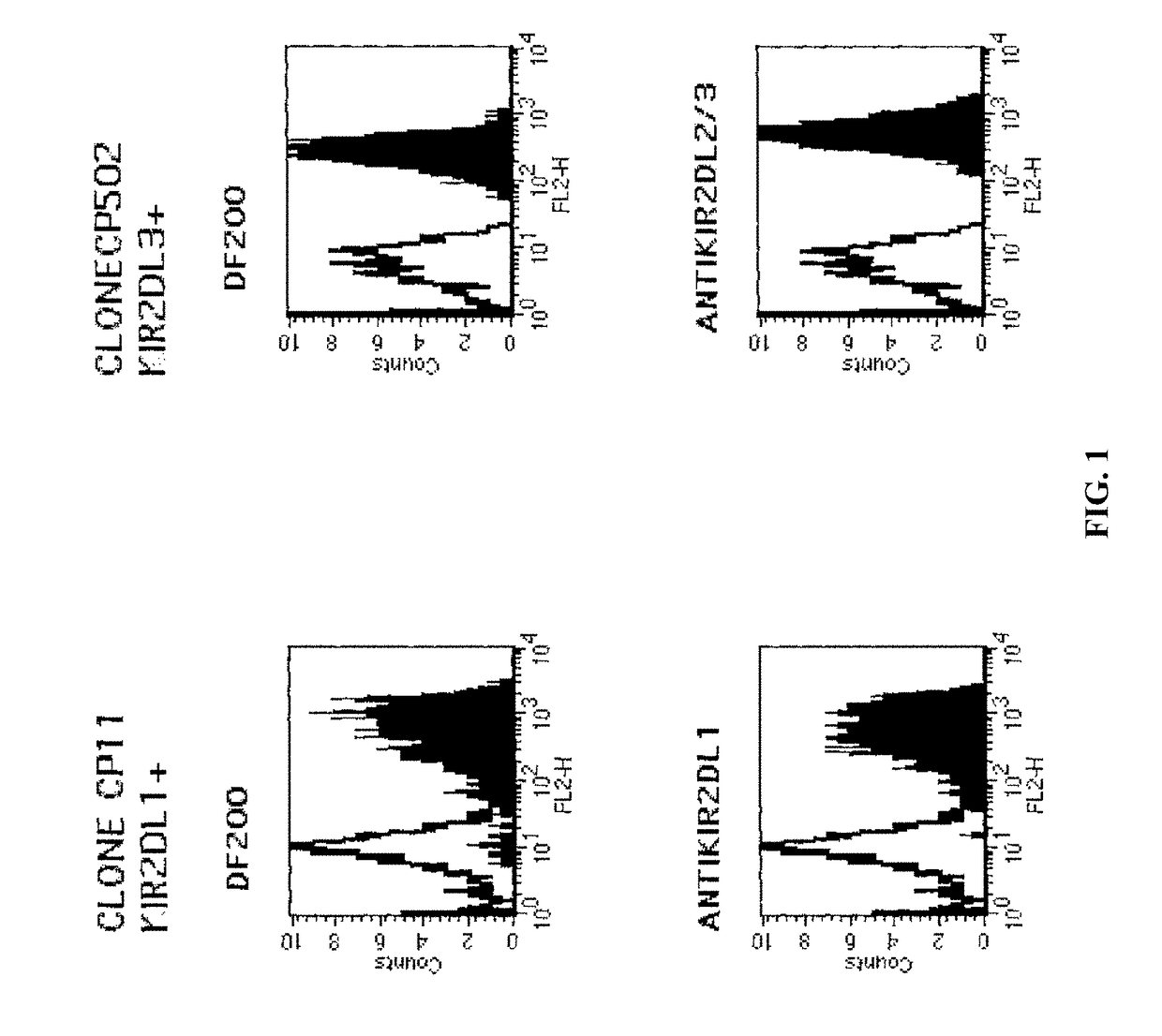Compositions and methods for regulating nk cell activity
a technology composition, which is applied in the field of composition and method of regulating nk cell activity, can solve the problems of unavailability of practical and effective approaches to modulation of nk cell activity, and the cost of treatment is much higher, so as to facilitate the activation of human nk cells, potentiation of nk cell cytotoxicity, and effective use
- Summary
- Abstract
- Description
- Claims
- Application Information
AI Technical Summary
Benefits of technology
Problems solved by technology
Method used
Image
Examples
example 1
Purification of PBLs and Generation of Polyclonal or Clonal NK Cell Lines.
[0210]PBLs were derived from healthy donors by Ficoll Hypaque gradients and depletion of plastic adherent cells. To obtain enriched NK cells, PBLs were incubated with anti CD3, anti CD4 and anti HLA-DR mAbs (30 minutes at 4° C.), followed by goat anti mouse magnetic beads (Dynal) (30 minutes at 4° C.) and immunomagnetic selection by methods known in the art (Pende et al., 1999). CD3−, CD4−, DR−cells were cultivated on irradiated feeder cells and 100 U / ml Interleukin 2 (Proleukin, Chiron Corporation) and 1.5 ng / ml Phytohemagglutinin A (Gibco BRL) to obtain polyclonal NK cell populations. NK cells were cloned by limiting dilution and clones of NK cells were characterized by flow cytometry for expression of cell surface receptors.
[0211]The mAbs used were JT3A (IgG2a, anti CD3), EB6 and GL183 (IgG1 anti KIR2DL1 and KIR2DL3 respectively), XA-1 41 IgM (anti KIR2DL1 with the same specificity as EB6), anti CD4 (HP2.6)...
example 2
Generation of New mAbs
[0215]mAbs were generated by immunizing 5 week old Balb C mice with activated polyclonal or monoclonal NK cell lines as described in (Moretta et al., 1990). After different cell fusions, the mAbs were first selected for their ability to cross-react with EB6 and GL183 positive NK cell lines and clones. Positive monoclonal antibodies were further screened for their ability to reconstitute lysis by EB6 positive or GL183 positive NK clones of Cw4 or Cw3 positive targets respectively.
[0216]Cell staining was carried out as follows. Cells were stained with a panel of antibodies (1 μg / ml or 50 μl supernatant, 30 mns at 4° C.) followed by PE-conjugated goat F(ab′)2 fragments anti-mouse IgG (H+L) or PE-conjugated goat F(ab′)2 fragment anti-human IgG (Fc gamma) antibodies (Beckman Coulter). Cytofluorometric analysis was performed on an Epics XL.MCL apparatus (Beckman Coulter).
[0217]One of the monoclonal antibodies, the DF200 mAb, was found to react with various members of...
example 4
Generation of New Human mAbs
[0222]Human monoclonal anti-KIR Abs were generated by immunizing transgenic mice engineered to express a human antibody repertoire with recombinant KIR protein. After different cell fusions, the mAbs were first selected for their ability to cross-react with immobilized KIR2DL1 and KIR2DL2 protein. Several monoclonal antibodies, including 1-7F9, 1-4F1, 1-6F5 and 1-6F1, were found to react with KIR2DL1 and KIR2DL2 / 3.
[0223]Positive monoclonal antibodies wore further screened for their ability to reconstitute lysis by EB6 positive NK transfectants expressing KIR2DL1 of Cw4-positive target cells. The NK cells expressing the HLA class 1-specific inhibitory receptors were used as effectors cells against target cells expressing one or more HLA-C alleles (FIGS. 5 and 6). Cytotoxicity assays were carried out as described above. The effector / target ratio is indicated in the Figures, and antibodies were used at either 10 ug / ml or 30 ug / ml.
[0224]As expected, KIR2DL1+ ...
PUM
| Property | Measurement | Unit |
|---|---|---|
| concentration | aaaaa | aaaaa |
| pH | aaaaa | aaaaa |
| concentration | aaaaa | aaaaa |
Abstract
Description
Claims
Application Information
 Login to View More
Login to View More - R&D
- Intellectual Property
- Life Sciences
- Materials
- Tech Scout
- Unparalleled Data Quality
- Higher Quality Content
- 60% Fewer Hallucinations
Browse by: Latest US Patents, China's latest patents, Technical Efficacy Thesaurus, Application Domain, Technology Topic, Popular Technical Reports.
© 2025 PatSnap. All rights reserved.Legal|Privacy policy|Modern Slavery Act Transparency Statement|Sitemap|About US| Contact US: help@patsnap.com



